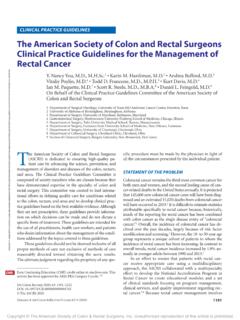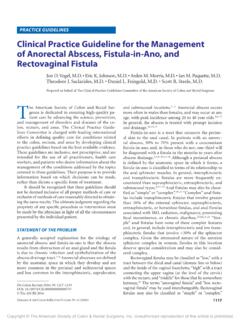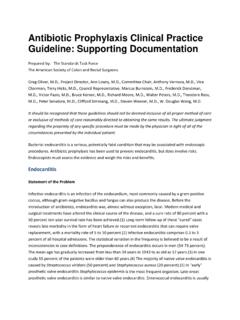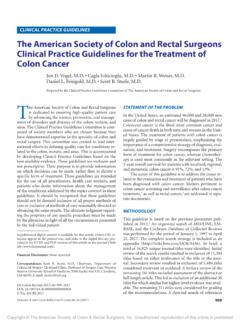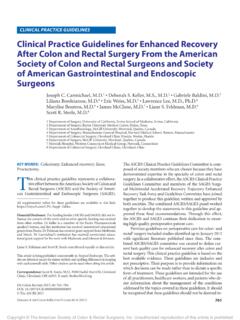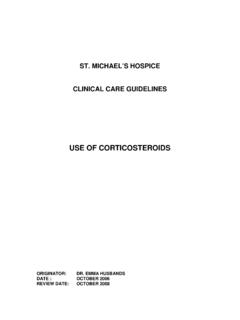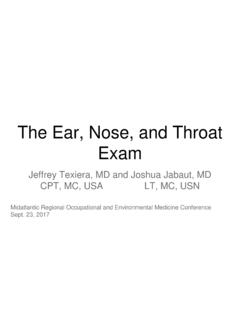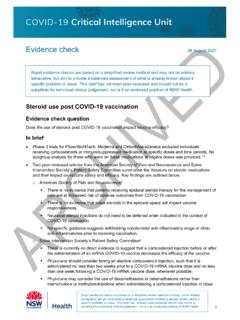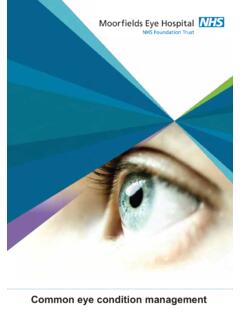Transcription of Clinical Practice Guideline for the Management of Anal ...
1 Copyright The American Society of Colon & Rectal Surgeons, Inc. Unauthorized reproduction of this article is of the Colon & ReCtum Volume 60: 1 (2017) the american society of Colon and Rectal surgeons is dedicated to ensuring high-quality patient care by advancing the science, prevention, and manage-ment of disorders and diseases of the colon, rectum, and anus. the Clinical Practice Guidelines Committee is com-posed of society members who are chosen because they have demonstrated expertise in the specialty of colon and rectal surgery. this committee was created to lead interna-tional efforts in defining quality care for conditions related to the colon, rectum, and anus.
2 This is accompanied by developing Clinical Practice guidelines based on the best available evidence. these guidelines are inclusive, and not prescriptive. their purpose is to provide information based on which decisions can be made, rather than to dictate a specific form of treatment. these guidelines are intended for the use of all practitioners, health care workers, and patients who desire information about the Management of the conditions addressed by the topics covered in these guidelines. it should be recognized that these guidelines should not be deemed inclusive of all proper methods of care or exclusive of methods of care reasonably directed toward obtaining the same results.
3 The ultimate judgment regarding the propriety of any specific procedure must be made by the physician in light of all the circumstances pre-sented by the individual OF THE PROBLEMthe term anal fissure most commonly refers to a longitudi-nal tear within the anal canal, one that typically extends from the dentate line toward the anal verge. this benign anorectal ailment is quite common, although there have been virtu-ally no published1 population-level data describing its inci-dence. Constipation and diarrhea are frequent antecedent historical features. the primary symptom associated with anal fissures is anal pain, which is often provoked by def-ecation and may last for several hours following defecation.
4 Anorectal bleeding may also be associated with fissures, and, when this symptom is present, it can contribute to a misdiagnosis of symptomatic hemorrhoids. in up to 90% of cases, the anal fissure is located within the posterior midline of the anal canal. fissures are located in the anterior midline in as many as 25% of female patients and in as many as 8% of male subjects. in 3% of patients, fissures can be located at posterior and anterior positions simultaneously. fissures located at lateral locations within the anal canal, and multi-ple fissures, are considered to be atypical and require careful evaluation because of their association with such diseases as hiV infection, Crohn s disease, syphilis, tuberculosis, and hematologic fissures, defined as symptoms present for fewer than 8 weeks, will appear as a longitudinal tear.
5 Fissures of a longer duration will manifest one or more stigmata of chronicity, including a hypertrophied anal papilla at the proximal aspect of the fissure, a sentinel tag at the distal aspect of the fissure, and exposed internal anal sphincter muscle within the base of the guidelines were built on the last set of the american society of Colon and Rectal surgeons Practice parameters for treatment of fissure-in-ano published in 2004. an orga-nized search of meDline, Pubmed, emBase, and the Co-chrane Database of Collected Reviews was performed from october 2015 through march 2016.
6 Retrieved publications were limited to the english language, but no limits on year of publication were applied. the search strategies were based on the concepts anal fissure and fissure-in-ano as primary search terms. searches were also performed based on various treatments for anal fissures, including anal fis-sure anD nitroglycerin, anal fissure anD nitrates, anal fissure anD diltiazem, anal fissure anD nifedipine, anal fissure anD fiber, anal fissure anD botulinum, anal fis-sure anD sphincterotomy, and anal fissure anD flap. Clinical Practice Guideline for the Management of Anal FissuresDavid B.
7 Stewart, Sr., Wolfgang Gaertner, Sean Glasgow, John Migaly, Daniel Feingold, Scott R. Steele, on behalf of the Clinical Practice Guidelines Committee of the american society of Colon and Rectal surgeonsDis Colon Rectum 2017; 60: 7 14 Doi: the asCRs 2016 Financial Disclosures: none Practice GUIDELINESC opyright The American Society of Colon & Rectal Surgeons, Inc. Unauthorized reproduction of this article is et al: Clinical Practice Guideline for anal fissure management8 Directed searches of the embedded references from the pri-mary articles were also performed in certain circumstances.
8 Prospective, randomized, controlled trials and meta-anal-yses were given preference in developing these guidelines. the final grade of recommendation was performed using the Grades of Recommendation, assessment, Develop-ment, and evaluation (GRaDe) system (table 1).2 RECOMMENDATIONS 1. Nonoperative treatment of acute anal fissures contin-ues to be safe, has few side effects, and should typically be the first-line treatment. Grade of Recommendation: Strong recommendation based on moderate-quality evidence, half of all patients who have acute anal fissure will resolve their symptoms with nonoperative measures such as sitz baths and the use of psyllium fiber or other bulking agents, with or without the addition of topical anesthetics or topical ,3 7 these interventions are well toler-ated, with minimal to no side effects.
9 Treatment with sitz baths and fiber supplementation is associated with a superi-or degree of pain relief in comparison with topical anesthet-ics and topical i n addition, maintenance therapy with fiber is associated with lower rates of fissure recurrence compared with t here are no data sup-porting one type of fiber in comparison with another. 2. Anal fissures may be treated with topical nitrates, al-though side effects may limit their efficacy. Grade of Recommendation: Strong recommendation based on high-quality evidence, nitric oxide donors are associated with healing in approximately 50% of chronic anal Based on a pooled analysis of studies, this represents a improvement in the absolute rate of healing and a 38% relative improvement in the rate of healing compared with placebo or lidocaine Dose escalation does not improve healing rates, but escalating doses are associated with an increased incidence of medication side.
10 11the principal side effect with this medication is head-aches, occurring in at least 30% of treated patients and being nearly ubiquitous in some ,12 this adverse effect is dose related and leads to the cessation of therapy in up to 20% of i n addition, up to 50% of pa-tients treated with this medication experience recurrent fissures, a significantly higher percentage than observed with surgical nonresponders to topical ni-trates should, in general, be considered either for botuli-num toxin therapy or for a surgical 1.

